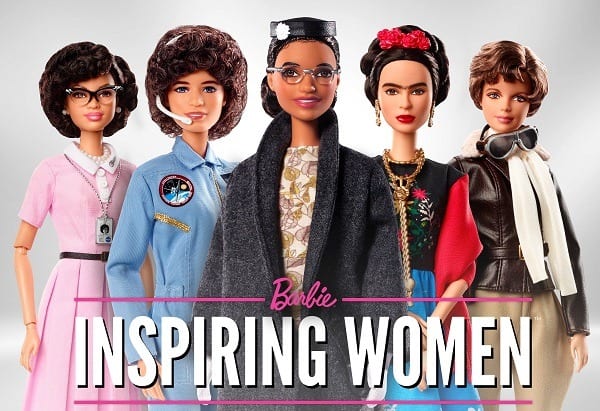Barbie’s parent company Mattel last week immortalised these legends in plastic on Women’s Equality Day as part of their Inspiring Women collection, which also features NASA mathematician Katherine Johnson and Mexican artist, Frida Kahlo.
Since 2015, the company has made a concerted effort to raise Barbie’s profile from an ambition-less play-thing with anatomically impossible proportions by introducing new collections of dolls including Shero (women heroes) and Inspiring Women.
We’re adding two courageous women to the #Barbie Inspiring Women Series – Civil Rights activist, Rosa Parks, and the first American woman to fly in space, Sally Ride.
Barbie Sally Ride doll: @Target
Barbie Rosa Parks doll: @Walmart
Or pre-order now: https://t.co/mnRXP0Sro3 pic.twitter.com/hZIdchCV1p— Barbie (@Barbie) August 26, 2019
The Shero line, which features a diverse group of accomplished women like Olympic boxer Nicola Adams and conservationist Bindi Irwin, aims to inspire young girls by shining a light on women who have made an impact in their chosen professions.
Mattel’s change of direction, however, may be too little, too late.
From the time of Barbie’s release in 1959, generations of girls have been subliminally brainwashed to aspire to thinness above all else, perpetuating toxic diet culture and conflating self-worth with body image.
Unsurprisingly, studies show that girls who play with the traditional iteration of the doll – the blond haired, baby blue-eyed, stick-thin figurine – experience a negative body image.
In response to decades of public outcry about the unrealistic beauty standards set by the plastic doll, Mattel released ‘curvy’, ‘tall’ and ‘petite’ dolls (with a greater range of skin tones, eye colours and hairstyles) as part of their Fashionistas range in 2016, marketing the collection as ‘more diverse than ever before’.
On the Fashionista’s webpage, however, the dolls are labelled by size – ‘tall’, ‘curvy’, ‘petite’ or ‘original’ – reducing them to a body type and subsequently intimating to young girls that their size defines them.
The Inspiring Women and Shero collections have certainly gone much further to address physical diversity.
The Shero collection includes cycling champion Kristina Vogel, who became paralysed after a cycling accident in 2018. Vogel is the one of only three Barbie dolls in a wheelchair.
The doll of Ibtihaj Muhammad, a champion Muslim-American fencer, features the hijab she wears to compete, including when she won a bronze medal at the 2016 Olympics.
But the brand still has a long way to go: the women of these collections been immortalised with conventionally pretty facial features, making them look remarkably similar despite their diverse backgrounds.
The Frida Kahlo doll is dressed in a long, traditional Mexican skirt and it’s highly unlikely that the leg brace she wore as a result of contracting polio as a child is underneath. While her monobrow, which she showed off with pride, does feature on the figurine, the lips have been plumped and eyes widened.
As Biba Kang wrote in an article published by The Independent, Kahlo’s unique features have been stripped back to appeal to a mass market:
“While Frida Kahlo’s doll has a slightly stronger brow than your average Barbie, makers still stopped short of letting it truly meet in the middle, and the smooth plastic skin will never be able to capture the ravishing hairiness of this wonderful, beautiful artist.”
Nicola Adams’ doll shares her haircut, but where the real Adams has muscular, defined arms, her Barbie replicas are thin.
Mattel’s biggest misstep, however, concerns the doll of US model and body image activist, Ashley Graham.
The company credits Graham as ‘an ambassador of the “real beauty” movement, which celebrates what real women’s bodies look like rather than the impossible standards set by the fashion industry’.
Ironically, it is these very same standards that Mattel has long been accused of pedalling; a real woman with Barbie’s dimensions would only have room for half a liver.
Why has Mattel been so intent on changing their business model after over five decades of success?
Global sales have been declining since 2009, in part because of an increasing demand for electronic toys, but also in large part due to parents’ concerns about the lasting impacts Barbie’s hypersexualised brand could have on children.
Declining sales and an increasingly woke audience demanding dolls be more role model than beauty queen has forced the company to re-strategize.
But it’s unlikely to be enough.
One study found that even Mattel’s ‘Career Barbie’ range was so overtly sexualised that young girls who played with the dolls still felt they had ‘significantly fewer future careers options than boys’.
A lasting criticism of the Shero range has been the lack of diversity of body type despite being based on role models with vastly different bodies.
The addition of Rosa Parks, Sally Ride and other inspirational women to the Barbie range undoubtedly increases her credibility as an aspirational, girl-friendly toy. Her long history as an icon of oppressive beauty standards, however, means it will be a long road if she is to regain supremacy on the toy shelves.


